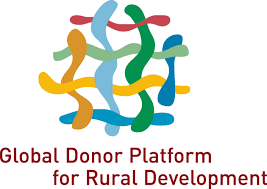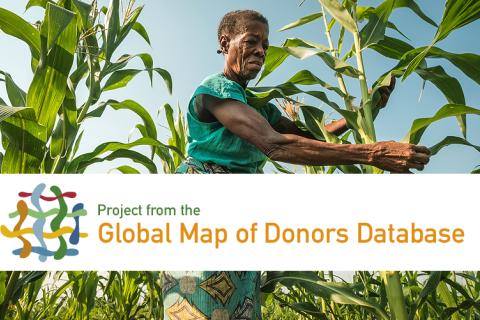The Global Donor Platform for Rural Development is a network of 38 bilateral and multilateral donors, international financing institutions, intergovernmental organisations and development agencies.
Members share a common vision that agriculture and rural development is central to poverty reduction, and a conviction that sustainable and efficient development requires a coordinated global approach.
Following years of relative decline in public investment in the sector, the Platform was created in 2003 to increase and improve the quality of development assistance in agriculture, rural development and food security.
// Agriculture is the key to poverty reduction
Agriculture, rural development, and food security provide the best opportunity for donors and partner country governments to leverage their efforts in the fight against poverty.
However, the potential of agriculture, rural development and food security to reduce poverty is poorly understood and underestimated.
Cutting-edge knowledge of these issues is often scattered among organisations, leading to competition, duplication of efforts, and delays in the uptake of best practices.
// Addressing aid effectiveness
Therefore the Platform promotes the principles of the Paris Declaration on Aid Effectiveness, the Accra Agenda for Action for sustainable outcomes on the ground, and the Busan Global Partnership for Effective Development Cooperation.
Increasing aid to agriculture and rural development is not enough. Donors must work together to maximise development impact.
// Adding value
The Platform adds value to its members’ efforts by facilitating the exchange of their development know-how, which consolidates into a robust knowledge base for joint advocacy work.
Working with the Platform, members are searching for new ways to improve the impact of aid in agriculture and rural development.
- An increased share of official development assistance going towards rural development
- Measurable progress in the implementation of aid effectiveness principles
- Greater use of programme-based and sector-wide approaches
- More sustainable support to ARD by member agencies
// Vision
The Platform endorses and works towards the common objectives of its member institutions to support the reduction of poverty in developing countries and enhance sustainable economic growth in rural areas.
Its vision is to be a collective, recognised and influential voice, adding value to and reinforcing the goals of aid effectiveness in the agricultural and rural development strategies and actions of member organisations in support of partner countries.
// Evaluation
Between August and October 2014, the Global Donor Platform for Rural Development underwent an Evaluation. The evaluators interviewed across board focal points (FPs) of member organisations, partner institutions, staff of the secretariat and key agricultural and rural development experts from different organisations involved in the Platform initiatives. KIT reviewed Platform documentation of the past 10 years, online resources and services to complete the assessment.
According to the report, the change in overall global development objectives of the Post-2015 agenda and its sustainable development goals (SDG) will only reiterate the relevance of the Platform’s work in coordinating donor activities. Agriculture and rural development are incorporated in many of the SDGs. The targeted development of appropriate policies and innovative strategies will depend on increased, cross-sectoral cooperation which the Platform stands for. The achievement of the Platform’s objectives of advocacy, knowledge sharing and network facilitation functions remains to be a crucial contribution to agriculture and rural development.
Members:
Resources
Displaying 201 - 205 of 808Integrated Land Use and Development Plan för Gambella
General
Project objective is to develop an integrated land use and development plan for the Gambella region. The plan to be developed in close consultation with a range of stakeholders such as Government, civil society, private sector and academia. Capacity building is a strong element in the project, as is forging a common view on land use in Gambella. Given the sensitivities and complexities in the region, the project will apply a conflict sensitive approach.
Women’s Land Rights for Inclusive Development and Growth in Africa
General
The overall objective is to ensure women’s access to and control over their land resources across Africa - supporting and enabling rural women’s voices. The action aims to effective independent and participatory monitoring by civil society of government progress on achieving targets related to the promotion of women’s land rights. In order to contribute to this goal, the action has three specific objectives: 1) Monitor actions taken by governments in key countries and Regional Economic Communities (RECs), and hold them accountable to implement relevant AU Women's Land Rights (WLR) instruments; 2) Empower rural women’s organizations to analyse, document and disseminate evidence on pronounced cases of missing WLR and action against the discriminatory land tenure systems and threats originating from large-scale land-based investments (LSLBIs); 3) Promote recognition of Pan-African civil society for its leadership, knowledge and effective advocacy capacity on women’s land rights.
Land administration development and Addresses for people and businesses
General
to ensure sustainability in the IT systems at KCA. The Norwegian Mapping Authority has also focused on building skills and capacity within and outside of KCA, so that the IT solutions are sustainable when aid from Norway is phased out. The IT solution provides better security, ensures uniform registration in all municipalities, and reduces corruption by ensuring that all changes are logged with reference to the person who made the change in the registry. The IT-system works towards a central database and thus establishing a connection for municipalities and users via the Internet. The roll out of the centralized, web based IT system to all municipalities. was completed by mid 2015, A KCA geoportal is developed and in operation.
Geographic information for development and European integration
General
Support to the establishment of a first National Mapping Agency for Albania , as justified in the national strategy for development and European integration.
Securing ownership to land
General
The project consists of three main components: •Establishing of six permanent reference stations for positioning services. These will complete the reference framework for the entire country and provide more accurate positioing. In addition, 30 GPS receivers will be acquired for surveying of property boundaries •Improvement of the IT-system for property registration. Today, this system is spread over several different components. This project will seek to harmonise the components and create one system. •Updating of property maps and register for 20% of the country where maps and register are still not up to date with new private properties


